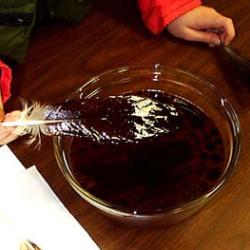Source Institutions
Source Institutions
Add to list Go to activity
Activity link broken? See if it's at the internet archive

In this experiment, learners examine the way oil affects bird feathers and test different cleanup methods to find out which works best. Learners answer questions throughout the investigation, reflecting on how birds are affected by oil spills and the best way to rescue birds after a spill.
- Under 5 minutes
- 10 to 30 minutes
- $1 - $5 per group of students
- Ages 6 - 14
- Activity, Experiment/Lab Activity, Simulation
- English
Quick Guide
Materials List (per group of students)
- Clean, dry feathers (good places to find feathers are beaches, parks, and pet stores)
- Four bowls
- Vegetable oil
- Dish-washing detergent
- Hot, cold, and room-temperature water (the hot water should be about the same temperature you'd use to wash dishes and not too hot to put your hands in)
- 1 tablespoon cocoa powder (optional)
Subjects
-
Life Sciences
-
Diversity of Life
- Animals
-
Ecology
- Human Impact
-
Diversity of Life
-
Physical Sciences
- Chemistry
-
States of Matter
- Liquids
-
The Nature of Science
-
Science and Society
- Risks and Benefits
-
The Scientific Process
- Asking Questions
- Conducting Investigations
- Gathering Data
- Formulating Explanations
- Communicating Results
-
Science and Society
-
The Nature of Technology
-
Technology and Society
- Impacts of Technology
- Technology and the Environment
-
Technology and Society
Informal Categories
- Animals
- Nature and Environment
Audience
To use this activity, learners need to:
- see
- read
- touch
Learning styles supported:
- Uses STEM to solve real-world problems
- Involves hands-on or lab activities
Other
Components that are part of this resource:
This resource is part of:
Access Rights:
- Free access
By:
Rights:
- All rights reserved, NOAA, 2008
